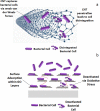A review of the potential of conventional and advanced membrane technology in the removal of pathogens from wastewater
- PMID: 35035270
- PMCID: PMC8741333
- DOI: 10.1016/j.seppur.2022.120454
A review of the potential of conventional and advanced membrane technology in the removal of pathogens from wastewater
Abstract
Consumption of pathogenic contaminated water has claimed the lives of many people. Hence, this scenario has emphasized the urgent need for research methods to avoid, treat and eliminate harmful pathogens in wastewater. Therefore, effective water treatment has become a matter of utmost importance. Membrane technology offers purer, cleaner, and pathogen-free water through the water separation method via a permeable membrane. Advanced membrane technology such as nanocomposite membrane, membrane distillation, membrane bioreactor, and photocatalytic membrane reactor can offer synergistic effects in removing pathogen through the integration of additional functionality and filtration in a single chamber. This paper also comprehensively discussed the application, challenges, and future perspective of the advanced membrane technology as a promising alternative in battling pathogenic microbial contaminants, which will also be beneficial and valuable in managing pandemics in the future as well as protecting human health and the environment. In addition, the potential of membrane technology in battling the ongoing global pandemic of coronavirus disease 2019 (COVID-19) was also discussed briefly.
Keywords: Advanced membrane technology; Membrane technology; Pathogen; Virus; Wastewater.
© 2022 Elsevier B.V. All rights reserved.
Conflict of interest statement
The authors declare that they have no known competing financial interests or personal relationships that could have appeared to influence the work reported in this paper.
Figures











References
-
- Gerardi M.H., Zimmerman M.C. John Wiley & Sons; 2004. Wastewater pathogens.
-
- R.W. Hofste, P. Reig, S. Leah, 17 Countries , Home to One- Quarter of the World ’ s Population , Face Extremely High Water Stress, World Resour. Inst. (2019) 1–7. https://www.wri.org/insights/17-countries-home-one-quarter-worlds-popula... (accessed October 21, 2021).
-
- Who . 4th ed., 2017. Guidelines for Drinking-water Quality.
Publication types
LinkOut - more resources
Full Text Sources
Other Literature Sources
